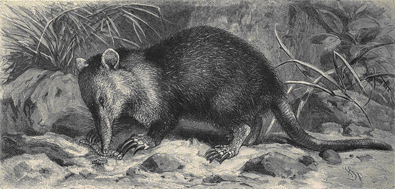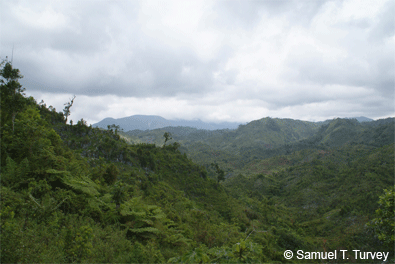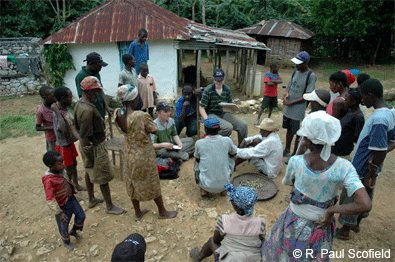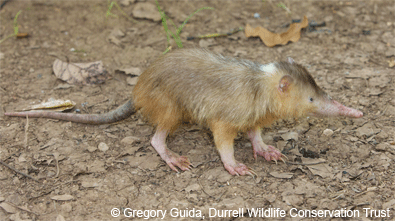[flashvideo filename=/Videos/0128solenodon.flv width=320 height=240 image=videos/solenodon_still.jpg /]
The Hispaniolan solenodon (Solenodon paradoxus), a top EDGE species, is one of the world’s weirdest mammals. The two living solenodon species diverged from all other living mammals 76 million years ago, when dinosaurs still walked the earth. The Hispaniolan solenodon and its distant cousin, the Cuban solenodon, are the only two mammal species that can inject venom into their prey through specialized grooves in their teeth (the name “solenodon” means “grooved tooth”). But life in the Caribbean hasn’t been as easy as it sounds. Over 100 mammal species have already died out on the islands of the West Indies as a direct result of human activities – hunting, deforestation, and the introduction of non-native predators – and the solenodons are now both highly threatened.

The Caribbean island of Hispaniola is divided into two countries, Haiti and the Dominican Republic. Haiti, the poorest country in the Western Hemisphere, has experienced one of the highest rates of deforestation of any country in the world, and its once-extensive tropical forests have been reduced to a few fragments. By the 1980s, solenodons had become extinct across the entire country except for the Massif de la Hotte, a remote mountainous region in southwest Haiti that supports a tremendous amount of unique biodiversity. But within a few years researchers had become pessimistic about even short-term survival of solenodons in this last refuge – forest clearance for land and charcoal was accelerating in the mountains, introduced dogs and mongooses were killing native mammals, and subsistence farmers were also opportunistically hunting any solenodons they could find. It was predicted that solenodons would be gone from the Massif de la Hotte by the start of the twenty-first century.
In April 2007 we visited the Massif de la Hotte, to find out what kind of mammal conservation activities would be appropriate in Haiti, and in particular to investigate the possibility that solenodons might still survive in the region’s mountains. Talking to local people in mountain villages, we found that Hispaniola’s sole surviving native rodent, the Hispaniolan hutia (Plagiodontia aedium), still seemed to be relatively common, but was greatly disliked because it damaged taro and bean crops. However, some villagers also reported that there was a second kind of “hutia” in the mountains, which differed from the common variety by having a much longer nose – its Creole name was “nen long” or “bouche long”. Everybody who knew about this second mammal thought that it was very rare. We were intrigued. Could this mysterious “nen long” be the solenodon?
Our suspicions were confirmed when the remains of three dead solenodons, all of which had died just before our arrival in the mountains, were brought to us by villagers. Of these animals, one had been caught and eaten by a local farmer, and another had probably been killed by an introduced mongoose – evidence that these threats continue to deplete Haiti’s fragile solenodon population. But, remarkably, these tenacious little mammals had managed to hang on after all. One clue about how this might have happened was revealed to us by the villagers. Apparently there had been a cull on dogs across the Massif de la Hotte region, because the dogs had killed too many chickens and goats on local farms. Had the removal of this potential solenodon predator helped the mountain’s native mammals to survive, too? We can’t be sure, but it might well be a factor.
Following the rediscovery of Haiti’s remnant solenodon population, we are now working to develop a large-scale solenodon conservation programme across Hispaniola in partnership with Durrell Wildlife Conservation Trust, Sociedad Ornitológica de la Hispaniola, Société Audubon Haïti, and the Dominican Republic’s National Zoological Park and Agency for Protected Areas and Biodiversity. The next stage in this conservation programme was a pilot project led recently by Durrell Wildlife Conservation Trust and Sociedad Ornitológica de la Hispaniola, to investigate exactly how it would be possible to monitor solenodons using different kinds of detection and trapping techniques. This project led to the successful capture (and subsequent release) of a solenodon in the Sierra de Bahoruco region of southern Dominican Republic. Film taken of this captured individual is among the only known footage of this remarkable, enigmatic, and highly threatened mammal species. Armed with the knowledge of how to actually survey solenodons, we are now planning further native mammal conservation work in both Haiti and the Dominican Republic.
If you want to support this crucial EDGE conservation programme, please click here


